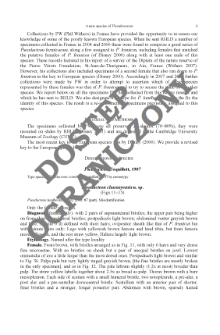- Search in all Repository
- Literature and maps
- Archeology
- Mills database
- Natural sciences
Advanced search
Advanced search
Advanced search
Advanced search
Advanced search

Object
Title: Natural history data and structural features of larvae of representatives of Anthiini (Coleoptera: Carabidae) with regard to their phylogenetic relationship
Subtitle:
Annales Zoologici / Museum and Institute of Zoology Polish Academy of Sciences, vol. 49, no 1-2
Contributor:
Muzeum i Instytut Zoologii Polskiej Akademii Nauk
Publisher:
Muzeum i Instytut Zoologii PAN
Place of publishing:
Description:
Incorrect ISSN 0001-6454 ; Bibliogr. p. 112 ; P. 101-112 : ill. ; 24 cm
Type of object:
Abstract:
Tee larval characters and natural history data of five species of Thermophilum Hope, Pachymorpha sexguttata Fabricius, two species of Cypholoba Chaudoir and Eccoptoptera sp are described and analysed phylogenetically. All taxa share the following peculiar larval apomorphies: a row of setae instead of two ground plan setae FR8,9 on adnasale, amembranous bulge between nasale and maxilla, ant ennomeres II+III fused, lacinia enlarged andfused with stipes, posterior claws reduced. Three different groups based on their natural historydata are found. One group with a large number of eggs from which hatch comparatively small larvae. A second group with a medium number of eggs which are fixed on the ceiling of the substrateholes. Both groups pass three active larval instars as in most other carabids. A third group with few, large eggs, a short first instar period, an unsclerotized second instar larva which is inactive,does not feed but pupates.The phylogenetic analysis confirms the sistergroup relationship of Helluonini and Anthiini,and the monophyly of Anthiini. Genus Eccoptoptera Chaudoir is the sister group of the large sized Anthiini including genus Cypholoba. The Cypholobini are non-monophyletic. T. sexmaculatum Fabricius is distinguished in several characters from the rest of Thermophilum species andshould be excluded from this genus. The maintenance of a monophyletic genus complex Anthias. l. Weber implies the convergent development of peculiar natural history characters in Cypholoba and T. sexmaculatum. Pachymorpha sexguttata and parts of the genusThermophilum form a well supported monophyletic group. Therefore, Pachymorpha Hope cannot be separated generically.
Relation:
Volume:
Issue:
Start page:
End page:
Detailed Resource Type:
Format:
Resource Identifier:
Source:
MiIZ PAN, call no. P.255, vol 49, no 1-2 ; MiIZ PAN, call no. P.4314, vol 49, no 1-2 ; click here to follow the link
Language:
Language of abstract:
Rights:
Rights Reserved - Restricted Access
Terms of use:
Digitizing institution:
Museum and Institute of Zoology of the Polish Academy of Sciences
Original in:
Library of the Museum and Institute of Zoology of the Polish Academy of Sciences
Projects co-financed by:
Programme Innovative Economy, 2010-2014, Priority Axis 2. R&D infrastructure ; European Union. European Regional Development Fund
Access:
Object collections:
- Digital Repository of Scientific Institutes > Partners' collections > Museum and Institute of Zoology PAS > Scientific Journals
- Digital Repository of Scientific Institutes > Partners' collections > Museum and Institute of Zoology PAS > MIZ PAN Publications > Annales Zoologici
- Digital Repository of Scientific Institutes > Literature > Journals/Articles
Last modified:
Feb 4, 2025
In our library since:
Jan 5, 2016
Number of object content downloads / hits:
36
All available object's versions:
https://rcin.org.pl./publication/74141
Show description in RDF format:
Show description in RDFa format:
Show description in OAI-PMH format:
Objects Similar
Ślipiński, Stanisław Adam
Grüm, Leszek
Ślipiński, Stanisław Adam Mazur, Sławomir
Grüm, Leszek
Grüm, Leszek

 INSTYTUT ARCHEOLOGII I ETNOLOGII POLSKIEJ AKADEMII NAUK
INSTYTUT ARCHEOLOGII I ETNOLOGII POLSKIEJ AKADEMII NAUK
 INSTYTUT BADAŃ LITERACKICH POLSKIEJ AKADEMII NAUK
INSTYTUT BADAŃ LITERACKICH POLSKIEJ AKADEMII NAUK
 INSTYTUT BADAWCZY LEŚNICTWA
INSTYTUT BADAWCZY LEŚNICTWA
 INSTYTUT BIOLOGII DOŚWIADCZALNEJ IM. MARCELEGO NENCKIEGO POLSKIEJ AKADEMII NAUK
INSTYTUT BIOLOGII DOŚWIADCZALNEJ IM. MARCELEGO NENCKIEGO POLSKIEJ AKADEMII NAUK
 INSTYTUT BIOLOGII SSAKÓW POLSKIEJ AKADEMII NAUK
INSTYTUT BIOLOGII SSAKÓW POLSKIEJ AKADEMII NAUK
 INSTYTUT CHEMII FIZYCZNEJ PAN
INSTYTUT CHEMII FIZYCZNEJ PAN
 INSTYTUT CHEMII ORGANICZNEJ PAN
INSTYTUT CHEMII ORGANICZNEJ PAN
 INSTYTUT FILOZOFII I SOCJOLOGII PAN
INSTYTUT FILOZOFII I SOCJOLOGII PAN
 INSTYTUT GEOGRAFII I PRZESTRZENNEGO ZAGOSPODAROWANIA PAN
INSTYTUT GEOGRAFII I PRZESTRZENNEGO ZAGOSPODAROWANIA PAN
 INSTYTUT HISTORII im. TADEUSZA MANTEUFFLA POLSKIEJ AKADEMII NAUK
INSTYTUT HISTORII im. TADEUSZA MANTEUFFLA POLSKIEJ AKADEMII NAUK
 INSTYTUT JĘZYKA POLSKIEGO POLSKIEJ AKADEMII NAUK
INSTYTUT JĘZYKA POLSKIEGO POLSKIEJ AKADEMII NAUK
 INSTYTUT MATEMATYCZNY PAN
INSTYTUT MATEMATYCZNY PAN
 INSTYTUT MEDYCYNY DOŚWIADCZALNEJ I KLINICZNEJ IM.MIROSŁAWA MOSSAKOWSKIEGO POLSKIEJ AKADEMII NAUK
INSTYTUT MEDYCYNY DOŚWIADCZALNEJ I KLINICZNEJ IM.MIROSŁAWA MOSSAKOWSKIEGO POLSKIEJ AKADEMII NAUK
 INSTYTUT PODSTAWOWYCH PROBLEMÓW TECHNIKI PAN
INSTYTUT PODSTAWOWYCH PROBLEMÓW TECHNIKI PAN
 INSTYTUT SLAWISTYKI PAN
INSTYTUT SLAWISTYKI PAN
 SIEĆ BADAWCZA ŁUKASIEWICZ - INSTYTUT TECHNOLOGII MATERIAŁÓW ELEKTRONICZNYCH
SIEĆ BADAWCZA ŁUKASIEWICZ - INSTYTUT TECHNOLOGII MATERIAŁÓW ELEKTRONICZNYCH
 MUZEUM I INSTYTUT ZOOLOGII POLSKIEJ AKADEMII NAUK
MUZEUM I INSTYTUT ZOOLOGII POLSKIEJ AKADEMII NAUK
 INSTYTUT BADAŃ SYSTEMOWYCH PAN
INSTYTUT BADAŃ SYSTEMOWYCH PAN
 INSTYTUT BOTANIKI IM. WŁADYSŁAWA SZAFERA POLSKIEJ AKADEMII NAUK
INSTYTUT BOTANIKI IM. WŁADYSŁAWA SZAFERA POLSKIEJ AKADEMII NAUK


































